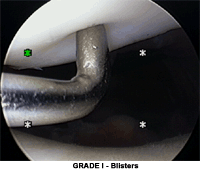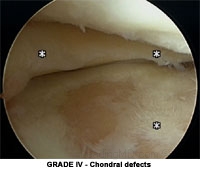 |
|
Showing
chondromalacia
|
Although symptoms may not appear until later
in life, articular cartilage problems are very common. Painful
osteoarthritis develops when this smooth, gliding surface
on the end of the bone has lost its cushioning, deformity
develops, and bone rubs on bone. Damage may occur as the result
of a sudden injury or wear and tear over many years. There
are some people with damaged articular cartilage who display
few symptoms and may not develop osteoarthritis until they
are elderly.
The development of ostearthritis
depends on several factors:
- The patient's age when
the degeneration starts
- The patient's activity
level and weight
- The presence of ligament
damage
Articular cartilage problems
can be particularly difficult to treat because the onset,
while occasionally sudden, often occurs gradually and thus
is not immediately detected.
What is articular cartilage
and what does it do?
There are two types of cartilage in the human knee:
- Meniscus
cartilage - This is the cartilage most commonly referred
to when the term "torn cartilage" is used. These
two rubbery shock absorbers sit between the upper bone of
the thigh (femur) and the large bone in the
lower leg (tibia).
- Articular cartilage
- This cartilage is the shiny, white surface that covers
the ends of most bones. Articular cartilage protects the
ends of bones and allows the joints to glide smoothly with
less friction. It also helps to spread the loads applied
to a joint. This covering is only a few millimeters thick
and it has no blood supply to facilitate the healing
process. Therefore, if it gets damaged, there is very
little capacity for healing.
What is an articular cartilage
injury?
An articular cartilage injury, or chondral injury,
may occur as a result of a pivot or twist on a bent knee,
similar to the motion that can cause a meniscus tear. Damage
may also be the result of a direct blow to the knee. Chondral
injuries may accompany an injury to a ligament, such as the
anterior cruciate ligament. Small pieces of
the articular cartilage can actually break off and float around
in the knee as loose bodies, causing locking,
catching, and/or swelling. More often, there is no clear history
of a single injury. The patient's condition may, in fact,
result from a series of minor injuries that have occurred
over time. Articular cartilage also wears down as a person
ages.
Chondral damage is graded from mild
to severe, and all grades can have characteristics of osteoarthritis.
 |
 |
- Grade I - The cartilage
"blisters" and becomes soft in the earliest form
of damage.
- Grade II and III -
As the condition worsens, the cartilage may become fibrillated
(it has a shredded appearance). The grade of injury
depends on the size of the involved area and how much of
the cartilage thickness is worn down. Noise as the knee
bends, called crepitus, may be present.
- Grade IV - The cartilage
may wear away completely, leaving the underlying bone exposed
in small or widespread areas. When the involved areas are
large, pain usually becomes more severe, causing a limitation
in activity.
|
